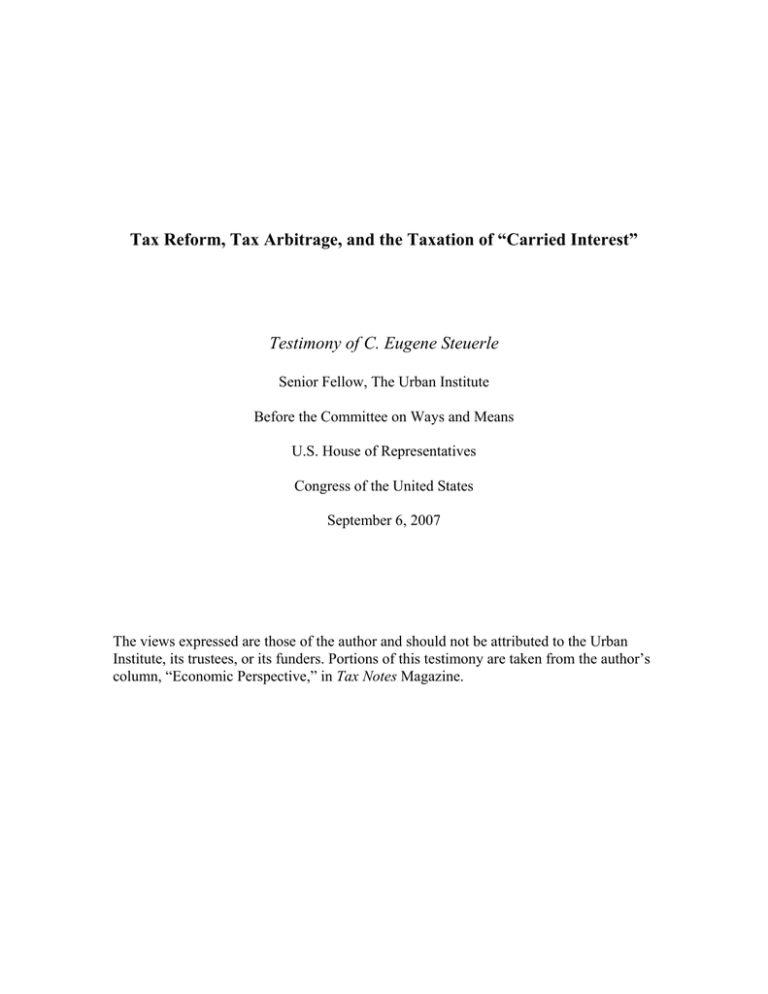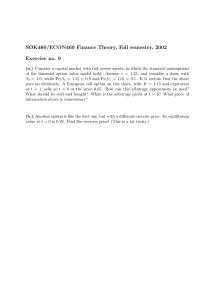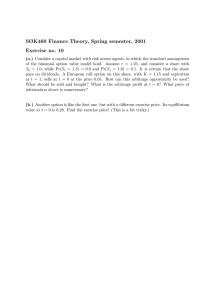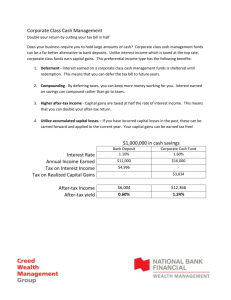Tax Reform, Tax Arbitrage, and the Taxation of “Carried Interest”
advertisement

Tax Reform, Tax Arbitrage, and the Taxation of “Carried Interest” Testimony of C. Eugene Steuerle Senior Fellow, The Urban Institute Before the Committee on Ways and Means U.S. House of Representatives Congress of the United States September 6, 2007 The views expressed are those of the author and should not be attributed to the Urban Institute, its trustees, or its funders. Portions of this testimony are taken from the author’s column, “Economic Perspective,” in Tax Notes Magazine. Mr. Chairman and Members of the Committee: Thank you for the invitation to testify before you today on the taxation of carried interest and its relationship to the broader issue of how a tax system should be designed to meet the goals of equity and efficiency. You have asked that I testify because of my experience as economic coordinator of the Treasury tax reform project leading to the Tax Reform Act of 1986 and, later, as deputy assistant secretary of the Treasury for tax analysis. In particular, I will address how we succeeded, at least in the view of many, in promoting equity and improving the performance of the U.S. economy. Note that the 1984–86 work was not really aimed at changing revenues or the progressivity of the tax system. The goals were efficiency and equal justice under the law for people in similar circumstances. A succinct summary of my conclusions today is as follows: • • • • • Any time Congress creates differentials in taxation, tax professionals are extraordinarily adept at leveraging up those differentials and applying them far and wide. As a matter of both efficiency and equity, capital gains relief is best targeted where tax rates are high, as in the case of the double taxation of corporate income. The case for providing capital gains relief for carried interest is relatively weak, resting primarily upon whether the administrative benefits of the simple partnership structure needs to be maintained in this arena; it does not rest upon arguments for favoring capital income, entrepreneurs, or risk. Many people pay high explicit or implicit rates of tax on their capital income, including those whose net worth is in interest-bearing accounts, welfare recipients, kids saving for college, and some owners of corporate equity. Relief might be more efficiently and fairly turned in their direction. Hopefully, Congress will one day turn to broader reform issues, including corporate integration and removing many differentials in taxation. The reasons stretch beyond tax policy to economic growth. For instance, the way that debt is favored over equity not only provides some of the juice for private equity firm transactions, regardless of how they are taxed, but builds up our debt-laden economy. Differentials in Taxation and Tax Arbitrage Let me get an important technical distinction out of the way first—the distinction between financial arbitrage and tax arbitrage. Financial arbitrage involves selling lowerreturn assets and buying higher-return assets. This activity is not confined to hedge-fund managers or private equity firms. Most households and businesses engage in financial 1 arbitrage when they borrow to buy a home or equipment that produces a higher return than the interest rate at which they borrowed. Tax arbitrage also works off of leverage, but it takes advantage of tax differentials, not necessarily any real productive opportunities. In the case of normal tax arbitrage, it involves the creation of additional assets and liabilities to effectively transfer ownership so that the most highly taxed items are owned by low- or zero-rate taxpayers, and the least highly taxed items are owned by taxpayers facing higher rates. The tax system has provided enormous incentives for creating a debt-magnified economy, so that interest-bearing accounts, bonds, and even implicit debt instruments can be held by nontaxpaying institutions and individuals, while those with higher tax rates then use those loans to hold onto other assets not so heavily taxed. Sometimes there are also “pure” tax arbitrage opportunities, whereby the taxpayer makes money essentially by borrowing from him- or herself. For instance, many households borrow and pay interest to buy retirement assets. Tax arbitrage explains how the United States can have such high rates of gross deposits in accounts and retirement plans and still have a negative personal saving rate. Tax arbitrage opportunities are created and enhanced when Congress establishes differential rates of taxation for certain types of income. Some of these differentials work off of the requirement that income be realized before it is taxed; some reflect inaccurate accounting for inflation; others work off of such differentials as capital gains versus ordinary income, debt versus equity, corporate versus noncorporate forms of organization, and taxable versus tax-exempt organizations. Many partnerships, including private equity firms and hedge funds, figure out ways to write off expenses immediately and in full, while declaring only a portion of currently accrued income or paying a lower rate on realized income. Others sell short or borrow from those in low or zero tax brackets, who, in turn, declare all nominal gains or interest receipts, including fictional income due to inflation, as taxable. Meanwhile, the interest deductions and short sale losses are fully written off by the higher bracket firm members or their clients. Their receipts and other positive declarations of income might be treated as capital gains or avoid taxation because they are not realized. One reason for the interest carried into this hearing—pun intended—is that tax arbitrage pervades the economy. One doesn’t even have to think about it to perform it. Think how common it is for individuals to put money into 401(k) accounts, then later borrow a little more on the house when the cash needed for a vacation is now tied up in the 401(k) account. Similarly, while many hedge fund managers and private equity firm partners might look mainly for financial arbitrage opportunities, at the same time their tax lawyers help them find ways to avoid tax, restructure deals and the character of their transactions, convert labor to capital gains income, and transfer money into and out of different instruments and tax jurisdictions. 2 You can quickly see how complex these issues can become. Not surprisingly, the issue of “what to do” correspondingly becomes complicated very quickly. If A is taxed favorably relative to B, who, in turn, is taxed favorably relative to C, then how can you create parity if you only make one change at a time? If you change the law to tax B like A, then C is further disadvantaged. If you instead change the law to tax B like C, then A is further advantaged. The equity issues are somewhat obvious. If my income is from widget making, which is favorably taxed, and yours from carpentry, which isn’t, then the tax laws discriminate against you as a carpenter. But the efficiency issues are extraordinarily important as well. I want to be absolutely clear. The tax arbitrage opportunities the tax system creates reduce national income and product, encourage too much production of some items and too little of others, shunt many talented individuals into less productive and sometimes nonproductive activities, and add substantially to the debt and other financial instruments in the economy. But when money gets invested for tax rather than economic reasons, the economy gets too much widget making and too little carpentry. Elsewhere, I have attempted to show how tax arbitrage drives the stagnation than accompanies higher rates of inflation. As a result, most tax theorists, whether liberal or conservative, Republican or Democrat or independent, believe that reducing and removing differentials helps promote a more vibrant and healthy economy, no matter what level of progressivity or revenues Congress sets. Taxing income equally regardless of source or use was one of the major principles accompanying the Tax Reform Act of 1986. Capital Gains Taxing income the same regardless of source, however, is easier said than done. In particular, take the case of capital gains, which is partly at the heart of the debate over carried interest. In a study that Professor Daniel Halperin of Harvard and I conducted years ago, we concluded that aggregate capital gains over time could almost all be attributed either to inflation or the retained earnings of corporations. I suspect that recently the bubble market in real estate and stock valuations might lead to additional gains over and above inflation and retained earnings, though these gains could be temporary (and modest when considered over several decades). In effect, then, much capital income can end up doubly taxed if there are not adjustments for inflation and income already taxed once at the corporate level. The first can be dealt with either by keeping inflation rates low, indexing the tax system for inflation, which is somewhat complex, or, as we do under current law, taxing net capital gains on a realization, rather than accrual, basis. The latter can be dealt with through corporate integration and also taxing on a realization basis. At one time, the corporate 3 integration debate centered mainly on dividends, but researchers have increasingly realized that capital gains can also be double taxed. In the U.S. tax system, corporate integration has been rejected in favor of simple relief for capital gains and dividends. The consequence is that some capital income is taxed at very low rates—it faces no corporate tax and an individual tax at a favored rate. Through adequate leveraging, some capital income, at least at the margin, is taxed at a negative rate. On the other hand, other capital income can be doubly or triply taxed if realized as accrued and subject to corporate, individual, and estate taxes—not to mention some of the myriad taxes like franchise taxes and property taxes on equipment that states sometimes employ. Besides inflation and the corporate tax, there is a third justification for capital gains relief. The U.S. tax system is mainly based upon the realization, not the accrual, of income. For many investors, then, realizing capital gains is discretionary, and the capital gains tax is a discretionary tax. Hence, whenever the tax on capital gains is lowered, people recognize more of their capital gains as income. This limits the revenue loss from capital gains relief, especially when tax rates are higher. Even if there were substantial revenues from higher capital-gains tax rates, people can get locked into holding onto their assets for tax rather than economic reasons. Hence, efficiency, too, argues for limiting the extent of “lock in.” Carried Interest So what does all this mean when applied narrowly to so-called carried interest and, more broadly, tax reform in general? Nowhere, as best I can tell, do those employing their brain power to make money through carried interests meet the classic justifications for capital gains relief—the avoidance of double taxation because the corporate income has already been taxed or because of inflation, or the prevention of too much lock in. A very strong case can also be made that carried interest income is more like labor income than capital income, although this distinction is arbitrary for the business owner. In any case, partners can put their own saving aside to achieve capital gains relief on that actual saving. And there are a variety of ways of charging customers for handling their money; I have great faith in the legal community’s ability to find ways to allocate real saving by a partnership into tax-preferred form. Moreover, entrepreneurial labor in these types of firms is already favorably treated—in this case, because we do not tax the accrual of partnership interests until they are realized. Admittedly, it is often difficult to separate capital from labor income, which is one reason for the simplified treatment of partnerships. Don’t forget, however, the other side of this coin: some entrepreneurial partners and sole proprietors in small businesses pay labor tax in the form of Social Security and Medicare tax on their capital income. Thus, we don’t allow self-employed cleaning people or home-based computer wizards or 4 restaurant owners to reduce their Social Security tax on the basis of an imputed return to their cleaning equipment, computers, or restaurant buildings. They stand in contrast to those who may pay capital gains tax and no Social Security and Medicare tax on some or most of their labor income. Some arguments against reform in this area need to be rejected. One is that capital taxes need to be kept moderate. There are better ways of keeping capital taxation at reasonable levels. One is corporate integration through forgiveness of capital gains and dividend taxation for income already taxed at the corporate level. Another is a lower corporate tax rate. Congress could also lower taxes for those who provide the real saving—the people who put money in bank accounts and don’t borrow elsewhere. Another misleading argument is that we should subsidize entrepreneurial labor. Again, yes, we should keep tax rates at a moderate level, but the tax system is never very good at defining who provides entrepreneurial labor and who does not. My guess is that, as in most business, some firms are very entrepreneurial at reallocating capital efficiently and some are very entrepreneurial at selling bad products to mislead investors or consumers. Why lower tax on this type of business but tax other entrepreneurial small and large business much more heavily? Moreover, to the extent there are temporarily forgone labor earnings or accrued property interests due to entrepreneurial efforts, these already receive favorable tax treatment, as they are expensed. That is, if I put $100,000 worth of my labor into a firm, and that $100,000 generates expertise and good will that is exchanged for a property interest that will provide cash returns later, then I really have earned $100,000 currently. But the tax code nonetheless allows me to write it off as an “investment” and expense the forgone earnings until I later begin to realize the actual cash returns. This labor income, then, is already preferred to earnings subject to tax immediately. Finally, some suggest that the tax Code should subsidize risk. This is not a tax policy argument. Some risk is good, some is bad; risk is certainly not good in and of itself. If risk is to be favored, in any case, one wouldn’t go into one select area with a lot of risk takers and throw money off the roof to them. Taxpayers Low and High Tax Rates on Their Capital Income I don’t want to skip over the disparities in tax rates faced by many different types of taxpayers. Some taxpayers do pay fairly high tax rates when they earn additional income: • A taxpayer in the 25 percent tax bracket whose entire savings are in a bank paying 4 percent interest in a world of 3 percent inflation effectively pays a tax rate of 100 percent on his 1 percent real return. • Asset tests and rules in many social welfare programs mean that a person saving a few extra dollars can lose thousands of dollars in benefits. Once again, this can 5 translate sometimes to confiscatory tax rates on additional capital income. The additional tax on the saving, measured as a percentage of the return to the saving, is often several hundred percent. • A student who cuts grass or babysits and saves the money in a bank account for college may pay not only tax on the initial earnings, but, more importantly, find that the loss of Pell grant assistance will be a substantial multiple of any interest earning on the saving. Thought of as a tax on capital income, it would be several hundred percent; thought of as a tax on entrepreneurial labor, the rate could be 67 percent or more. On the flip side, many other individuals, not just those in firms with carried interest or handling private equity or venture capital, face fairly low tax rates, thanks mainly to tax arbitrage and the failure to recognize income. • Many people remember Leona Helmsley’s famous quip that “Only the little people pay taxes.” But what many failed to realize is that many owners of real estate, such as Ms. Helmsley, effectively achieved their low tax rate through the tax arbitrage made possible by highly leveraged investment. One of the more revelatory moments in the 1984–86 reform process came when a group lobbied against tax reform on the basis that it wanted the progressivity made possible by high tax rates. It turned out that the group represented the tax shelter industry, which liked the high tax rates that applied to their deductions, such as for interest expense. • The very rich generally pay individual tax rates that are effectively 10 percent or less on their accrued income, since they only occasionally realize this income for tax purposes. Even if capital gains were given no preference, their effective tax rates would remain very low. However, some pay significant corporate tax on their income, depending upon how highly leveraged they are at the individual and corporate levels. • Another way that some higher-income persons pay lower rates (and an issue for carried interests and private equity) is through avoidance of that portion of the Social Security tax associated with Medicare—the Hospital Insurance tax. As noted, many sole proprietors and partnerships pay this tax on all their returns from these businesses, even returns that might be thought of as returns to capital. Meanwhile, those who get such income counted as capital or capital gain income avoid this tax altogether for that income. Broader Reform Issues Given all the differentials in the tax system, it is easy for almost anyone to argue that someone is making out even better. The complication is that serious analysis requires recognizing that lowering one person’s relative tax burden by definition means raising 6 another’s. Taxes are a price of government, and their aggregate level is set largely by the level of expenditures of government, not by current collections. The basic principles of taxation lead to many of the same conclusions today as when we were constructing major tax reform two decades ago: • Whenever possible, tax differentials should be reduced. This is not an issue of progressivity or revenues but of efficiency and equal justice under the law for those in equal circumstances. • Removal of differentials should not mean the creation of new differentials through double taxes. Efforts still need to be expended on removing double taxation of capital gains and dividends and avoidance of a high inflation tax or subsidy for debt. • If the tax on capital income is to be lowered, relief should be concentrated broadly, as through corporate integration or a lower corporate tax rate. • Labor income should be taxed similarly regardless of source. • The Tax Code should not favor debt over equity. Currently, this provides some of the juice can generate profits for private equity firms without any necessary gain to the economy from the transactions—regardless of what tax rate the partners pay. • Given the very high tax rates many low- and moderate-income taxpayers face, we probably ought to pay more attention to the taxation of their assets and returns from capital. The reasons for the opposite, upside-down focus on providing relief mainly for the richest and most successful members of society seems driven more by lobbying dollars than economic considerations. Finally, let me offer one additional suggestion for which there is also an analogy with tax reform days. In the mid-1980s, the Treasury engaged the IRS in studies of the various ways income was being sheltered from tax. Congress found these data useful in considering what changes it would undertake. As I have noted, tax professionals exhibit an enormous ability to take advantage of differentials in taxation. I suggest that Congress ask the Treasury and IRS to engage in a much more serious and continual effort— combining policy, statistics, and enforcement personnel—to expose who, at various income levels, pay multiple taxes and who pay little or no tax at all. 7





